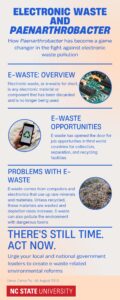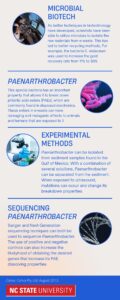Team 4 Spring 2022


Introduction
Over the last 20 years, electronic devices have evolved from entertaining gadgets to use sparingly to something that is permanently integrated into our lives. This integration has caused the excessive need for electronics; this excessive usage of technology eventually becomes waste after a while due to improvements in newer technologies or becoming outdated. Therefore, waste has been an increasing issue throughout communities around the world. Electronic waste, viewed by some, benefits job opportunities in 3rd world countries by being able to provide an alternate way to generate outcomes. However, electronic waste savaging poses health risks by exposing workers to high amounts of lithium and other toxic metals. Additionally, the overuse of electronic waste in 1st world countries is not excused from these issues as well. Much of the metals that are used such as gold, platinum, tin, and cobalt, are materials that are in limited abundance. With the lack of proper recycling of these materials, eventually, there will be an exhaustion of resources, leading to an electronic shortage that is essential to modern infrastructure. In summary, electronic waste is a problem that can be viewed from multiple angles; but the commonality between each of these perspectives is that they can all have equal ramifications on how people function in their communities and society.
Microbial Solutions
The term environmental biotechnology is defined as biotechnology that addresses environmental problems. This includes the use of microorganisms to improve environmental quality. An example of this is how microbes and bacteria are used in recycling electronics. Recycling rare earth metals through pyrometallurgy involves heating e-waste to high temperatures, releasing toxic gasses, not to mention the sheer amount of energy required. Scientists have been researching microorganisms that may help with this problem.
Take, for example, the microorganisms C. violaceum. This microbe was used to recover gold from e-waste. It did this by producing an enzyme that converts glycine to hydrogen cyanide. The cyanide ions bind to gold atoms from the e-waste scraps. However, this bacterium was unable to produce enough cyanide to remove gold efficiently. Luckily, microorganisms can be manipulated by scientists, and researchers engineered a new strain that increased the amount of gold recovered from 11% to 30%. This is a good start, but through further experimentation, it can be drastically increased. Scientists grew the microbes separately implementing strategies to make their yield greater, and the amount of gold rose to 69%.
Experimental Approach
Our bacteria, Paenarthrobacter, originates from marine sediment from North America in Southeast Texas and throughout The Gulf of Mexico. The bacteria was isolated from its environmental source by taking 1 gram of marine sediment and adding it to 50 mL of minimum medium composed of the following compounds: Na2SO4, CaCl2, NH4Cl, MgCl2⋅6H2O, NaMoO4⋅2H2O, FeSO4, NaCl, K2HPO4, KH2PO4, and phenanthrene (Paenarthrobacter sp. GOM3 Is a Novel Marine Species With Monoaromatic Degradation Relevance, 2021).
Afterward, the bacteria are incubated at 200 rpm and 30°C for 3 months, and every 30 days, the bacterial colony is transferred to a fresh minimum medium. For sequencing, the bacteria were performed on an Illumina NextSeq 500 platform after using a paired-end protocol of 75 cycles. Meanwhile, the assembly used the paired-end reads obtained from Illumina sequencing for de novo genome assembly with Velvet v1.2.10 (Zerbino, 2010), with a k-mer size of 63.
We could trigger mutations in the bacteria to produce more of the enzymes that break down e-waste. Instead of mixing the e-waste with the bacteria, we could grow the bacteria separately, and soak the e-waste in the catalyst, allowing the microbes to do less work when ultimately mixed together. Exposing the microbes to ultrasound by placing it in an ultrasonicator device increases the mixing of the culture. The pressure waves bring the microbes closer to the nutrients it needs to extract rare earth metals.
Microbe: Paenarthrobacter
The bacteria, Paenarthrobacter, has many species and can be used for more than just the metal degradation aspect of e-waste. There is also a study on Paenarthrobacter’s use as a degradation tool of plasticizers such as phthalic acid esters which are industrially produced by the million-ton scale per year. Phthalic acid esters (PAEs) exhibit endocrine-disrupting, carcinogenic, teratogenic, and mutagenic effects on wildlife and humans. These compounds are found in a variety of products such as paints, polishers, lubricants, adhesives, pulp and paper industries, children’s toys, and cosmetic products. PAEs are also found in the plastic components of e-waste, and high levels of human exposure to PAEs have been found in e-waste recycling areas. The study from the Saravan landfill in Iran identified Paenarthrobacter sp. Shss one of the most effective PAE degrading bacteria known, and one that requires further research into its elimination of di-n-butyl phthalate.
Future Directions
Deciding on a sequencing method to harness the genes in the Paenarthrobacter bacteria will depend on the process that is most efficient in providing information. Sequences such as Sanger and Next-Generation are sequencing methods that can improve the efficiency of finding DNA information in organisms. Moreover, what the group plans to do in regards to analyzing this bacteria is to consider alternate ways of finding controls and using them. Placing both a positive and negative control will be useful in deciphering different information in the DNA of the bacteria. Additionally, being knowledgeable on how to interpret the DNA to develop a report for others to use is essential for creating an effective experiment. Therefore, for future directions, the experiment would devise the use of positive control and would be governed by the variables that circulate it.
References
- “Breathing’ Bacteria Clean up Toxic Waste | College | College of Science and Engineering.” Umn.edu. N.p., 2022. Web. 15 Feb. 2022.
- Sebastien Farnaud. “We’re Using Microbes to Clean up Toxic Electronic Waste – Here’s How.” The Conversation. N.p., 19 Aug. 2020. Web. 15 Feb. 2022.
- “Microbial Communities Clean Toxic Waste and Generate Useful Chemicals.” Biodesign Institute | ASU. N.p., 2020. Web. 15 Feb. 2022.
- Dykes, Jacob. “Bioleaching: Using Bacteria to Recycle Precious Metals from Electronic Waste – Geographical Magazine.” Geographical.co.uk. N.p., 2021. Web. 15 Feb. 2022.
- Kwok, Roberta. “Inner Workings: How Bacteria Could Help Recycle Electronic Waste.” Proceedings of the National Academy of Sciences 116.3 (2019): 711–713. Web. 15 Feb. 2022.
- Anmar Frangoul. “In New Zealand, Microbes Are Extracting Gold from Electronic Waste.” CNBC. CNBC, 2 Oct. 2020. Web. 15 Feb. 2022.
- Ezeonu, Chukwuma S. et al. “Biotechnological Tools for Environmental Sustainability: Prospects and Challenges for Environments in Nigeria—a Standard Review.” Biotechnology Research International 2012 (2012): 1–26. Web. 30 Mar. 2022.
- “How Bacteria Could Help Recycle Electronic Waste.” PNAS. N.p., 2019. Web. 30 Mar. 2022.
Rosas-Díaz J, Escobar-Zepeda A, Adaya L, Rojas-Vargas J, Cuervo-Amaya DH, Sánchez-Reyes A and Pardo-López L (2021) Paenarthrobacter sp. GOM3 Is a Novel Marine Species With Monoaromatic Degradation Relevance. Front. Microbiol. 12:713702. doi: 10.3389/fmicb.2021.713702